Lorelei
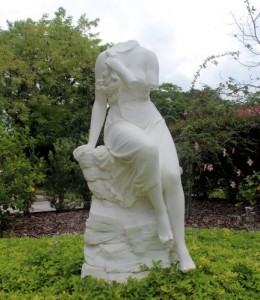 Although not Fort Myers’ first public artwork, Lorelei is certainly its oldest. The white marble sculpture dates back to circa 1880, when her creator, Boston-born Emma Elisabeth Phinney, carved her in Italy from a single block of stone measuring 60-68 inches high. She is on view in the Hibiscus Garden at the Fort Myers Lee County Garden Council on Virginia Street in downtown Fort Myers, where she was moved on January 6, 2014 after the public library on Central Avenue moved to its new 40,000-square-foot home at the corner of First Street and Royal Palm Avenue.
Although not Fort Myers’ first public artwork, Lorelei is certainly its oldest. The white marble sculpture dates back to circa 1880, when her creator, Boston-born Emma Elisabeth Phinney, carved her in Italy from a single block of stone measuring 60-68 inches high. She is on view in the Hibiscus Garden at the Fort Myers Lee County Garden Council on Virginia Street in downtown Fort Myers, where she was moved on January 6, 2014 after the public library on Central Avenue moved to its new 40,000-square-foot home at the corner of First Street and Royal Palm Avenue.
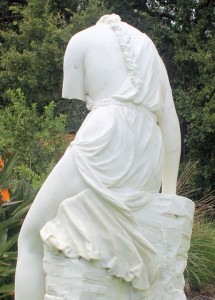 What remains of Lorelei is enchanting, from the folds of her sleeveless shift to the long braid of hair cascading down her back. Unfortunately, today the head, left elbow and two of the toes of her left foot are missing. The damage was perpetrated by one or more nameless vandals in 1997. The missing parts have never been recovered.
What remains of Lorelei is enchanting, from the folds of her sleeveless shift to the long braid of hair cascading down her back. Unfortunately, today the head, left elbow and two of the toes of her left foot are missing. The damage was perpetrated by one or more nameless vandals in 1997. The missing parts have never been recovered.
The figure reclines on a pedestal carved in the shape of stacked shale, the type of rock found on the island in the Rhine River which also bears her name. The workmanship is delicate; the piece rich in intricate details that are not obvious on mere cursory glance. Pearls dangle from a thick braid of hair and follow the contour of her 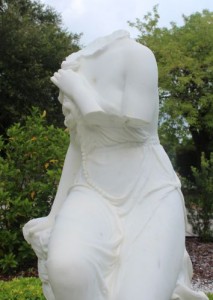 right thigh before being lost in a fold of her form-hugging gown. Dainty fingertips hover above the teeth of the comb that rests on the stone beside her. Her narrow waist is circled by a finely-carved belt, and ferns and flowers decorate the shale that forms the pedestal on which Lorelei lounges languorously.
right thigh before being lost in a fold of her form-hugging gown. Dainty fingertips hover above the teeth of the comb that rests on the stone beside her. Her narrow waist is circled by a finely-carved belt, and ferns and flowers decorate the shale that forms the pedestal on which Lorelei lounges languorously.
Many of these intricacies were eclipsed from view by the hedge and plantings that surrounded her in the landscaping bed she occupied for more than half a century outside the old Fort Myers-Lee County Public Library. But these and other features are now enticingly on display in Lorelei‘s new home in the Berne Davis Gardens at the Garden Council, which has assumed responsibility for her care, 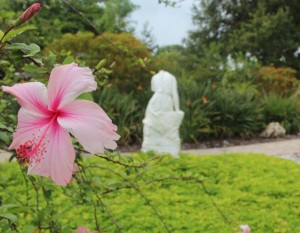 custody and conservation going forward.
custody and conservation going forward.
The Fort Myers-Lee County Garden Council is located at 2166 Virginia Avenue (off McGregor Blvd), Fort Myers, Florida 33901. For days and times of operation, please telephone (239) 332-4942 or visit http://www.fmlcgardencouncil.com.
The Sculptor
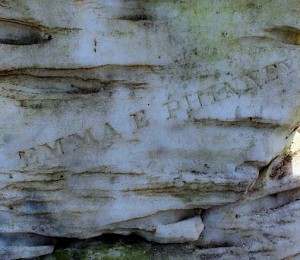 Lorelei‘s sculptor was Emma Elisabeth Phinney. The New York Times interviewed her in Rome on May 26, 1881. She was there studying at the Royal Academy of Fine Arts, the best art school in the ancient city. Phinney was one of the first women to receive a degree from the Royal Academy “following its thorough reorganization by the Italian government.”
Lorelei‘s sculptor was Emma Elisabeth Phinney. The New York Times interviewed her in Rome on May 26, 1881. She was there studying at the Royal Academy of Fine Arts, the best art school in the ancient city. Phinney was one of the first women to receive a degree from the Royal Academy “following its thorough reorganization by the Italian government.”
According to the Times, Phinney’s “short career 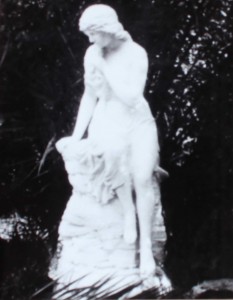 as an art student has been crowned with more than the usual success. Within the five years she has been at work, she has produced several popular statues; those that have attracted the most attention being a Lorelei, the bust of a North American Indian, and one of a negro [sic] boy formerly in the Grosvenor Gallery in London and now on exhibit in the Paris Salon. Mrs. Phinney is a realist in art, as these subjects testify.”
as an art student has been crowned with more than the usual success. Within the five years she has been at work, she has produced several popular statues; those that have attracted the most attention being a Lorelei, the bust of a North American Indian, and one of a negro [sic] boy formerly in the Grosvenor Gallery in London and now on exhibit in the Paris Salon. Mrs. Phinney is a realist in art, as these subjects testify.”
At the Royal Academy, Phinney studied under sculptor Luigi Amici and alongside Antonio Rossetti. Amici’s greatest work is regarded to be the tomb of Pope Gregory XIV in St. Peter’s, although he also contributed sculptures for the fountain located 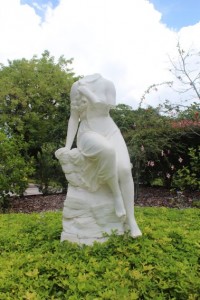 in the Piazza Navona. Rossetti executed a number of works in Britain, including The Nubian Slave (c.1858) in the botanical gardens at Kibble Palace in Glasgow and The Reading Girl (1883) at the Lichfield Public Library, of which an earlier copy (1873) known as Time is Precious‘ is in the Walker Art Gallery in Liverpool.
in the Piazza Navona. Rossetti executed a number of works in Britain, including The Nubian Slave (c.1858) in the botanical gardens at Kibble Palace in Glasgow and The Reading Girl (1883) at the Lichfield Public Library, of which an earlier copy (1873) known as Time is Precious‘ is in the Walker Art Gallery in Liverpool.
At the June 1880 Grosvenor Gallery exhibition referenced in the Times article, Phinney exhibited with Henrietta S. Montalba, Evelyn Pickering and Alice Chaplin. Art Journal Magazine not only praised her bronze bust, but opined that she and her co-exhibitors held their own with their male counterparts.
While Phinney is mentioned in Who Was Who in American Art, 1564-1975, published in 3 volumes in 1999 by Peter Hastings Falk, no information has been found regarding her later work or career.
History of the Lorelei
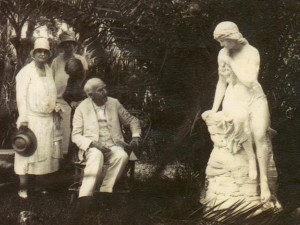 The sculpture was purchased by Evelyn D. Rea in 1930 during a trip to Italy. A member of the Periwinkle Garden Club, Rea maintained a well-tended garden with a small goldfish pond at her residence on the Caloosahatchee River not far from the Burroughs House. It is there that she put the Lorelei on display. Among the guests who admired the sculpture over the years were Thomas and Mina Edison, Mrs. Hitchcock, and Evelyn’s
The sculpture was purchased by Evelyn D. Rea in 1930 during a trip to Italy. A member of the Periwinkle Garden Club, Rea maintained a well-tended garden with a small goldfish pond at her residence on the Caloosahatchee River not far from the Burroughs House. It is there that she put the Lorelei on display. Among the guests who admired the sculpture over the years were Thomas and Mina Edison, Mrs. Hitchcock, and Evelyn’s 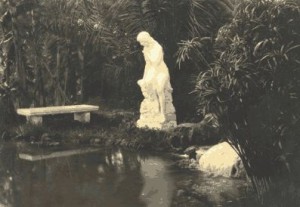 neighbor from across the street, Mrs. Clarence B. Chadwick.
neighbor from across the street, Mrs. Clarence B. Chadwick.
Banyan author Cynthia A. Williams was another early admirer. In a 2014 blog post, Williams recounts her first encounter with Lorelei when she was a young girl. “As I was walking the seawall bordering the Rea estate, I must have glimpsed a bit of white in my peripheral vision, for I 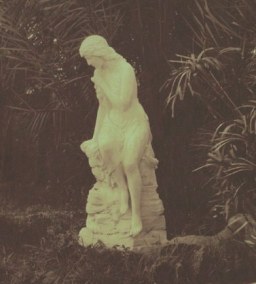 stopped on the seawall and turned and saw her. I don’t think I breathed for a full minute. She was more beautiful than anything I had ever seen in my life. I honestly could not believe what I was seeing. Stepping down off the seawall, mindful that I was trespassing on private property, I approached her cautiously, as to a shrine. The curves of her body were liquid, graceful as cool, slow-curling milk. Her small, perfect face was tilted downward on a neck as gently curved as the stem of a new flower. The thick braid trailing over one soft shoulder was intertwined with a rope of pearls and her dainty white fingertips, pearl-like themselves,
stopped on the seawall and turned and saw her. I don’t think I breathed for a full minute. She was more beautiful than anything I had ever seen in my life. I honestly could not believe what I was seeing. Stepping down off the seawall, mindful that I was trespassing on private property, I approached her cautiously, as to a shrine. The curves of her body were liquid, graceful as cool, slow-curling milk. Her small, perfect face was tilted downward on a neck as gently curved as the stem of a new flower. The thick braid trailing over one soft shoulder was intertwined with a rope of pearls and her dainty white fingertips, pearl-like themselves, 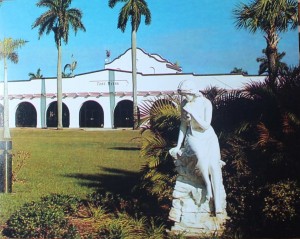 hovered just above the teeth of the comb beside her on the bench.
hovered just above the teeth of the comb beside her on the bench.
Williams writes that from that moment, Lorelei was her secret mermaid. “I began to visit her secretly, always on tip toe, and finally, defying Authority, which dogs the footsteps of children, I touched the pearls in her hair, the teeth of her comb. Her marble shoulders were cool to the hesitant palms of my hands. I glanced frequently 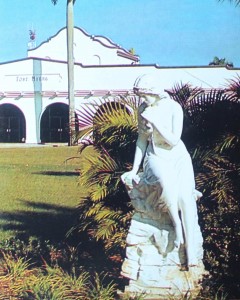 toward the house across the sweeping lawn, nervous that the old woman in the house would see me.”
toward the house across the sweeping lawn, nervous that the old woman in the house would see me.”
The old woman would have probably welcomed the child’s adoration of the Italian marble. After all, she once felt those same emotions – when she saw, purchased and brought Lorelei home. And though no record of her thoughts or motives remains today, Rea bequeathed Lorelei to the Public Library of Fort Myers in her Last Will and Testament dated July 20, 1955. After Rea died in 1959 and the period for creditors to file their claims against the estate closed some time in 1960, the sculpture was distributed to the library.
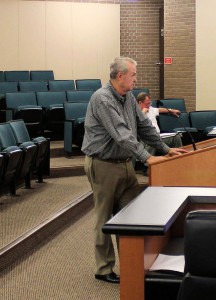 According to Fort Myers resident James Butler, the statue languished in storage at the library until in 1961. “I asked to borrow it to use at our senior prom at the Exhibition Hall. There was so much dirt and dust on the piece that it was muddy grey. We cleaned it and used it for the centerpiece of the dance,” the theme of which was the Gardens of Elysium (which in Greek mythology was the final resting place of the heroic and the virtuous). “When it was returned to the library, the staff was impressed by the newly cleaned marble and had it placed in front of the building.”
According to Fort Myers resident James Butler, the statue languished in storage at the library until in 1961. “I asked to borrow it to use at our senior prom at the Exhibition Hall. There was so much dirt and dust on the piece that it was muddy grey. We cleaned it and used it for the centerpiece of the dance,” the theme of which was the Gardens of Elysium (which in Greek mythology was the final resting place of the heroic and the virtuous). “When it was returned to the library, the staff was impressed by the newly cleaned marble and had it placed in front of the building.”
It graced the library’s entry from that time until the night of October 29, 1997, when one or more vandals knocked off her head along with 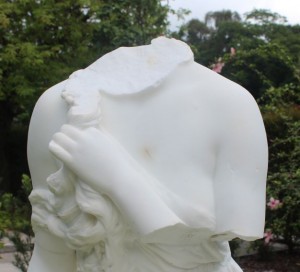 a piece of one arm and some toes. The culprit(s) were never caught and the head has never been recovered. “I was hoping when they cut away all the bushes and brambles, then they’d find the head,” said Sally Jane, who was the reference librarian at the time. “We never knew who did it. It wasn’t like they left a note saying, ‘I got your head.’ It just disappeared.”
a piece of one arm and some toes. The culprit(s) were never caught and the head has never been recovered. “I was hoping when they cut away all the bushes and brambles, then they’d find the head,” said Sally Jane, who was the reference librarian at the time. “We never knew who did it. It wasn’t like they left a note saying, ‘I got your head.’ It just disappeared.”
The library wrapped the damaged statue in plastic and tape while they contemplated what to do. The 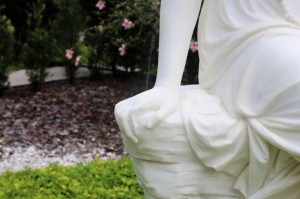 damaged Lorelei caused a rift among library personnel. “We had a great debate about whether to remove it or try to repair it, and repairing it was problematical,” recalls Jane. Meanwhile, people sent indignant letters to the News-Press Mailbag. Raul Jordan of Fort Myers wrote, for example: “With sadness I noticed that the statue rests on its pedestal armless and headless only in a grotesque
damaged Lorelei caused a rift among library personnel. “We had a great debate about whether to remove it or try to repair it, and repairing it was problematical,” recalls Jane. Meanwhile, people sent indignant letters to the News-Press Mailbag. Raul Jordan of Fort Myers wrote, for example: “With sadness I noticed that the statue rests on its pedestal armless and headless only in a grotesque 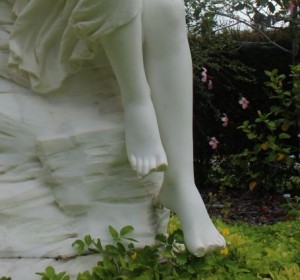 pile of worthless stone. Two thoughts come to my mind: Either mystically we believe that the wicked goddess taken away from the green-blue waters of the Mediterranean chanted herself to self-destruction; or that our city fathers do not show appreciation for valuable art and simply do not give a ‘siren’ about it.”
pile of worthless stone. Two thoughts come to my mind: Either mystically we believe that the wicked goddess taken away from the green-blue waters of the Mediterranean chanted herself to self-destruction; or that our city fathers do not show appreciation for valuable art and simply do not give a ‘siren’ about it.”
In the end, the library removed the packing and left the enchantress to languish headless outside their front entrance. In truth, the technology to 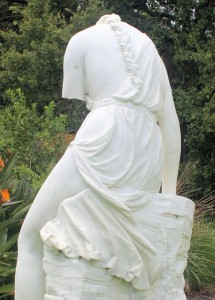 restore the sculpture did not exist back then. It was only in 1999 that researchers at Florida Atlantic University developed computer algorithms that now make it possible to fabricate a new head, elbow and toes for decapitated siren using historic photographs of the sculpture as it looked in 1930 when Ms. Rea brought her to Fort Myers. Even so, conservators Rosa Lowinger and Lauren Hall don’t think a new head, elbow or toes should be fabricated for the sculpture.
restore the sculpture did not exist back then. It was only in 1999 that researchers at Florida Atlantic University developed computer algorithms that now make it possible to fabricate a new head, elbow and toes for decapitated siren using historic photographs of the sculpture as it looked in 1930 when Ms. Rea brought her to Fort Myers. Even so, conservators Rosa Lowinger and Lauren Hall don’t think a new head, elbow or toes should be fabricated for the sculpture.
“From a conservation standpoint, these elements can be recreated; however it is [our] opinion that the piece could be equally exhibited without those portions added,” state conservationists Rosa Lowinger 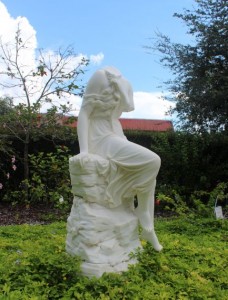 and Lauren Hall in a May 15, 2013 conservation report commissioned by the Fort Myers Public Art Committee. “It is possible to refabricate elements that could be put in place to simulate the original components. It is our opinion, however, that the extensive invention, cost, and simulacra that this would constitute would leave the piece heavily restored.”
and Lauren Hall in a May 15, 2013 conservation report commissioned by the Fort Myers Public Art Committee. “It is possible to refabricate elements that could be put in place to simulate the original components. It is our opinion, however, that the extensive invention, cost, and simulacra that this would constitute would leave the piece heavily restored.”
The Public Art Committee has accepted the conservators’ recommendation and Lorelei will continue to be exhibited without her head and other missing body parts.
Relocation to the Fort Myers Lee County Garden Council
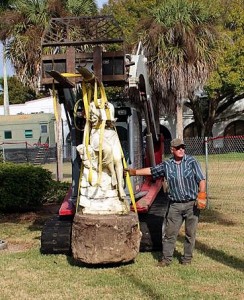 Lorelei was relocated to the Fort Myers Lee County Garden Council on January 6, 2014, with the firm of Flint & Doyle digging up Lorelei and transporting her gratis to her new home in the Hibiscus Garden at the Fort Myers-Lee County Garden Council. “We are over-the-top excited to bring her here,” said Second Vice-President Sandy Kavouras as the statue was being placed by Flint & Doyle in the Hibiscus Garden next to the front entry. “It feels like she’s finally coming home.”
Lorelei was relocated to the Fort Myers Lee County Garden Council on January 6, 2014, with the firm of Flint & Doyle digging up Lorelei and transporting her gratis to her new home in the Hibiscus Garden at the Fort Myers-Lee County Garden Council. “We are over-the-top excited to bring her here,” said Second Vice-President Sandy Kavouras as the statue was being placed by Flint & Doyle in the Hibiscus Garden next to the front entry. “It feels like she’s finally coming home.”
Kavouras is referring, of course, to the fact that Rea was a member of the Periwinkle Garden Club, which was one of nine 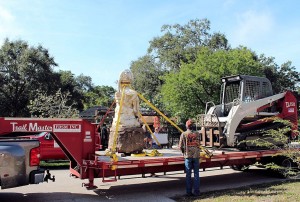 garden clubs that banded together in 1957 to form the Garden Council. Today, the Periwinkle is one of twenty member garden clubs, eight plant societies and two affiliates that comprise the Garden Council, which represents more than 1,800 individual members throughout Southwest Florida.
garden clubs that banded together in 1957 to form the Garden Council. Today, the Periwinkle is one of twenty member garden clubs, eight plant societies and two affiliates that comprise the Garden Council, which represents more than 1,800 individual members throughout Southwest Florida.
Conservation of the Sculpture
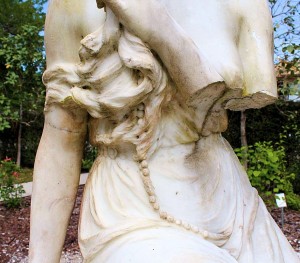 When Lorelei arrived at the Garden Council, she was in dire need of significant conservation. The surface of the sculpture was covered with dirt, grime, mold, mildew, fungus and lichen, largely because the sculpture had been surrounded for more than 50 years by firebrush hedge, which served to hold moisture against the surface of the stone. The marble had suffered spalling in several areas, most notably on the siren’s right elbow, and “portions of the surface were slightly friable to the
When Lorelei arrived at the Garden Council, she was in dire need of significant conservation. The surface of the sculpture was covered with dirt, grime, mold, mildew, fungus and lichen, largely because the sculpture had been surrounded for more than 50 years by firebrush hedge, which served to hold moisture against the surface of the stone. The marble had suffered spalling in several areas, most notably on the siren’s right elbow, and “portions of the surface were slightly friable to the 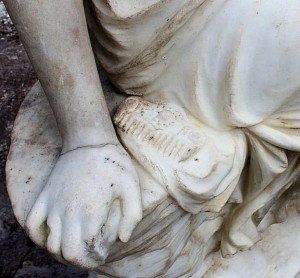 touch, particularly areas that were exposed to constant direct sunlight.”
touch, particularly areas that were exposed to constant direct sunlight.”
In furtherance of its agreement with the Public Art Committee, the Garden Council engaged Rosa Lowinger & Associates to perform the work necessary to clean and stabilize the stone. A full-service conservation firm specializing in the preservation of sculpture, architectural elements, three-dimensional artwork and contemporary art, RLA is considered a national leader in 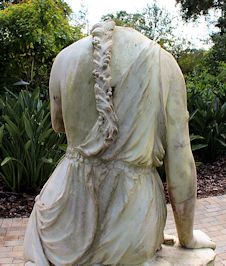 preservation and conservation of art in the public sector.
preservation and conservation of art in the public sector.
The first step in the sculpture’s conservation consisted of washing the marble with filtered water and a conservation grade detergent to remove dirt, grime and soluable salts. Poultices were applied to remove staining, and a fungicide was used to mitigate discoloration from mold and fungus and provide residual protection to the surface. But the most intricate and important part of the process involved injecting epoxy into the marble to stabilize and repair the spalling that had occurred over time.
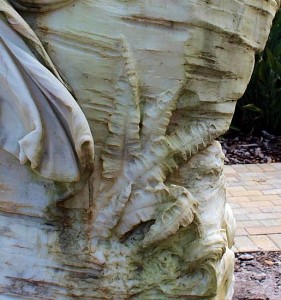 The difference in Lorelei’s outward appearance following these measures is stunning. Today, the marble virtually gleams in the sunlight, showing off Emma Elisabeth’s Phinney’s intricate and well-executed craftsmanship. Details that had been lost in the grime and mold, like the comb at the siren’s right hand and the flowers carved into the stacked shale plinth, jump out and, from a distance, the body and flowing shift are infused with a fluid, languid movement.
The difference in Lorelei’s outward appearance following these measures is stunning. Today, the marble virtually gleams in the sunlight, showing off Emma Elisabeth’s Phinney’s intricate and well-executed craftsmanship. Details that had been lost in the grime and mold, like the comb at the siren’s right hand and the flowers carved into the stacked shale plinth, jump out and, from a distance, the body and flowing shift are infused with a fluid, languid movement.
The foregoing work was performed on January 6 and 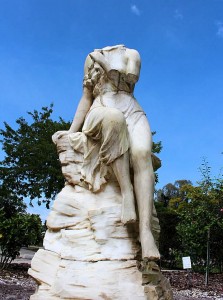 7, 2015 at a cost of more than $6,000. But Lorelei is not out of danger yet. At her current location in the Hibiscus Garden, the sculpture is once again surrounded by plant material that holds moisture against the surface of the stone. In addition, the sculpture’s surfaces are dotted during the highly-humid summer months by the protective cases or cocoons of the larva of dozens of moths known as plaster bagworms or household casebearers. And with no shade or cover, the marble is still being exposed to the harmful effects of UV light, rain and wind. While the first two issues can be easily remedied by eliminating the ground cover that’s touching the plinth, hand removing the
7, 2015 at a cost of more than $6,000. But Lorelei is not out of danger yet. At her current location in the Hibiscus Garden, the sculpture is once again surrounded by plant material that holds moisture against the surface of the stone. In addition, the sculpture’s surfaces are dotted during the highly-humid summer months by the protective cases or cocoons of the larva of dozens of moths known as plaster bagworms or household casebearers. And with no shade or cover, the marble is still being exposed to the harmful effects of UV light, rain and wind. While the first two issues can be easily remedied by eliminating the ground cover that’s touching the plinth, hand removing the 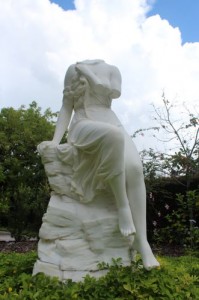 bagworm bags and treating nearby planting beds with soil-borne bacteria that kills the caterpillars without harming beneficial insects, pets or humans, protecting the sculpture from direct sunlight and rain might require the construction of a costly gazebo, niche or similar structure. The Garden Council was not aware of this requirement when it assumed responsibility for Lorelei’s care and custody, but the organization is committed to doing everything necessary to protect the sculpture and is exploring a number of options for raising funds for this purpose.
bagworm bags and treating nearby planting beds with soil-borne bacteria that kills the caterpillars without harming beneficial insects, pets or humans, protecting the sculpture from direct sunlight and rain might require the construction of a costly gazebo, niche or similar structure. The Garden Council was not aware of this requirement when it assumed responsibility for Lorelei’s care and custody, but the organization is committed to doing everything necessary to protect the sculpture and is exploring a number of options for raising funds for this purpose.
The Legend
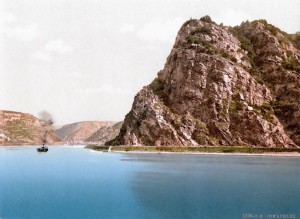 Lorelei comes from a picturesque section of the Rhine River valley in central Germany. But she’s not a seductive young siren. Instead she is a rock that rises 435 feet above the surface of the river across from Rheinfels Fortress in St. Goar (right), not far from Schoenberg Castle (also known as Castle Cat) in Sankt Goarshausen. Since the Middle Ages, this part of the river has been
Lorelei comes from a picturesque section of the Rhine River valley in central Germany. But she’s not a seductive young siren. Instead she is a rock that rises 435 feet above the surface of the river across from Rheinfels Fortress in St. Goar (right), not far from Schoenberg Castle (also known as Castle Cat) in Sankt Goarshausen. Since the Middle Ages, this part of the river has been 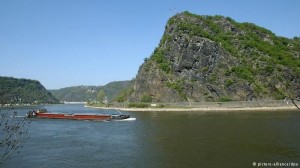 regarded by mariners and fishermen as the most treacherous stretch of the Rhine. Passage is narrow, and the current runs swift and deep. Many a boat has smashed into the jagged shoreline of the cliff and foundered on the rocks at Lorelei’s feet. Not surprisingly, river travelers and locals
regarded by mariners and fishermen as the most treacherous stretch of the Rhine. Passage is narrow, and the current runs swift and deep. Many a boat has smashed into the jagged shoreline of the cliff and foundered on the rocks at Lorelei’s feet. Not surprisingly, river travelers and locals 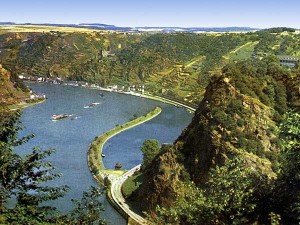 humanized the cliff, creating stories in verse, lyric and prose about a siren named Lorelei. According to the legend, Lorelei was a distraught young maiden who threw herself into the river in despair over a feckless lover. She was transformed in death into a siren or mermaid whose hypnotic music ever after lured sailors and fishermen to their death.
humanized the cliff, creating stories in verse, lyric and prose about a siren named Lorelei. According to the legend, Lorelei was a distraught young maiden who threw herself into the river in despair over a feckless lover. She was transformed in death into a siren or mermaid whose hypnotic music ever after lured sailors and fishermen to their death.
Sailors claim the Lorelei’s song is loveliest they’ve 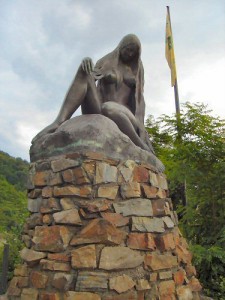 ever heard. The sound originates from the water lapping against the rocks at the base of the cliff, which then echoes throughout the surrounding hillside vineyards. On a clear night, after the daily drone of whining engines and rubber on asphalt has subsided for the day, you can still hear Lorelei’s melodic tune, which many liken to a young woman plaintively singing (although some characterize the echoes as sinister, wrath-filled laughter). Either way, the siren’s song lures boaters toward seven jagged boulders lurking just beneath the surface of the water at Lorelei’s base. Called the seven virgins, the rocks pose a threat to boats that travel the river even today.
ever heard. The sound originates from the water lapping against the rocks at the base of the cliff, which then echoes throughout the surrounding hillside vineyards. On a clear night, after the daily drone of whining engines and rubber on asphalt has subsided for the day, you can still hear Lorelei’s melodic tune, which many liken to a young woman plaintively singing (although some characterize the echoes as sinister, wrath-filled laughter). Either way, the siren’s song lures boaters toward seven jagged boulders lurking just beneath the surface of the water at Lorelei’s base. Called the seven virgins, the rocks pose a threat to boats that travel the river even today.
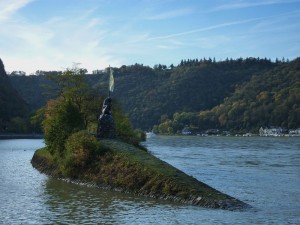 In 2011, a tanker carrying 2,400 tons of sulfuric acid capsized after it struck Loralei, killing two crew members and blocking ship traffic on the Rhine from Mainz to Koblenz for more than a week. A pontoon and four cranes were required to raise the tanker from the river’s rocky bottom. The cause of the accident remains unclear to this day.
In 2011, a tanker carrying 2,400 tons of sulfuric acid capsized after it struck Loralei, killing two crew members and blocking ship traffic on the Rhine from Mainz to Koblenz for more than a week. A pontoon and four cranes were required to raise the tanker from the river’s rocky bottom. The cause of the accident remains unclear to this day.
The Rhine is the longest river in Germany, and 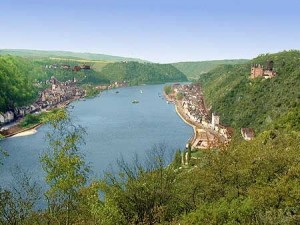 runs from the Swiss Alps to the North Sea in the Netherlands. The river’s commercial use dates back to the Roman Empire, when the Rhine formed the empire’s northern frontier. More than 60,000 ships travel the river annually, transporting some 60 million tons of goods. Several cities and municipalities, including Duisburg and Düsseldorf, rely on the river as a source of drinking water. Until 2011, there had not
runs from the Swiss Alps to the North Sea in the Netherlands. The river’s commercial use dates back to the Roman Empire, when the Rhine formed the empire’s northern frontier. More than 60,000 ships travel the river annually, transporting some 60 million tons of goods. Several cities and municipalities, including Duisburg and Düsseldorf, rely on the river as a source of drinking water. Until 2011, there had not  been a major accident at the site of the Loralei rock in the past 30 years.
been a major accident at the site of the Loralei rock in the past 30 years.
Lorelei and German Poet Henrich Heine
Perhaps the most famous literary work dedicated to the legend of Lorelei was penned by Heinrich Heine in 1823. Titled Die Lorelei, it reads:
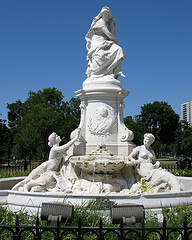 I wish I knew the meaning,
I wish I knew the meaning,- A sadness has fallen on me.
- The ghost of an ancient legend
- That will not let me be.
- The air is cool in the twilight
- And gently flows the Rhine;
- A mountain peak in the setting sun
- Catches the faltering shine.
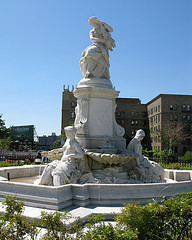 The highest peak still gleaming
The highest peak still gleaming- Reveals enthroned in the air,
- A Siren lost in her dreaming
- Combing her golden hair.
- With golden combs she caresses
- Her hair as she sings her song;
- Echoing through the gloaming
- Filled with a magic so strong.
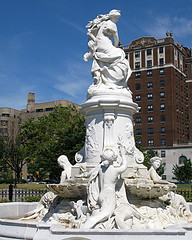 The boatman has heard, it has bound him
The boatman has heard, it has bound him- In throes of desire and love.
- He’s blind to the reefs that surround him,
- He sees but the Maiden above.
- And now wild waters awaken
- Then boat and boatman are gone.
- And this is what her singing,
- The Loralei has done.
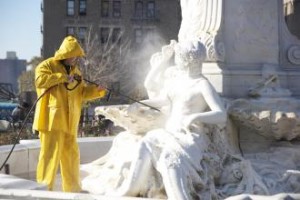 Following Heine’s death, German sculptor Ernest Herter was commissioned by Empress Elizabeth of Austria to create a fountain memorializing Lorelei for the poet’s home city, Dusseldorf. However, political groups blocked its installation there because of Heine’s Jewish origins and his dissident political views against the rising tide of German nationalism. The fountain was purchased by a German-American group in 1893, who installed it in the Bronx in 1899. Soon after its installation, the sculptures were vandalized and the fountain endured decades of deterioration and tagging by graffiti writers. The Lorelei fountain and the surrounding landscape were finally restored in 1999 (left) with $1.87 million in funds allocated by the mayor, the city council and the borough president. Fully restored, the Lorelei fountain sits today Joyce Kilmer Park, which is located at the corner of Grand Concourse and 161st Street, directly across from the Bronx County Courthouse.
Following Heine’s death, German sculptor Ernest Herter was commissioned by Empress Elizabeth of Austria to create a fountain memorializing Lorelei for the poet’s home city, Dusseldorf. However, political groups blocked its installation there because of Heine’s Jewish origins and his dissident political views against the rising tide of German nationalism. The fountain was purchased by a German-American group in 1893, who installed it in the Bronx in 1899. Soon after its installation, the sculptures were vandalized and the fountain endured decades of deterioration and tagging by graffiti writers. The Lorelei fountain and the surrounding landscape were finally restored in 1999 (left) with $1.87 million in funds allocated by the mayor, the city council and the borough president. Fully restored, the Lorelei fountain sits today Joyce Kilmer Park, which is located at the corner of Grand Concourse and 161st Street, directly across from the Bronx County Courthouse.
The marble sculptural group depicts Lorelei seated on a rock in the Rhine River among mermaids, dolphins and seashells. The bas relief around the pedestal includes a profile of Heine.
Location and Measurements.
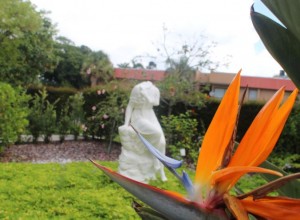 The sculpture is located at 2166 Virginia Ave, Fort Myers, FL 33901.
The sculpture is located at 2166 Virginia Ave, Fort Myers, FL 33901.- It is at Latitude 26 degrees, 63 minutes and 4.543 seconds and Longitude 81 degrees, 87 minutes and 7.368 seconds.
- Lorelei sits on a pedestal that stands 34 inches tall.
- The sculpture is 62 inches tall from the bottom of the pedestal to the top of the siren’s neck.
- Lorelei is 26 inches across at her widest point, which is from her knee to her right hand.
- The sculpture is 20 inches deep at her widest point.
Acknowledgment.
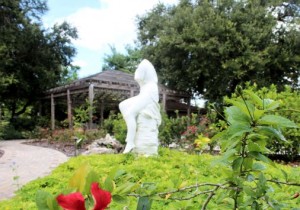 The author acknowledges the contribution of Fort Myers resident James Butler, who provided much of the information about the history of this sculpture. In fact, this entire profile would not have been possible without the research binder and photographs he has compiled and maintained over the years.
The author acknowledges the contribution of Fort Myers resident James Butler, who provided much of the information about the history of this sculpture. In fact, this entire profile would not have been possible without the research binder and photographs he has compiled and maintained over the years.
Fun Facts.
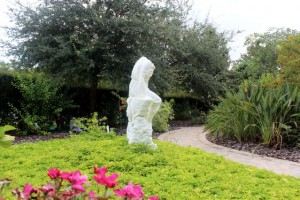 No photograph or rendering of Emma Elisabeth Phinney has been located.
No photograph or rendering of Emma Elisabeth Phinney has been located.- The Southwest Florida Museum of History maintains a booklet titled “The Epic of the Fort Myers – Lee County Library” by Richard Powell which states on page 9, “In [1959] … a gift of a lovely statue named Lorelei was willed to the library by Mrs. Evelyn D. Rhea (sic), who
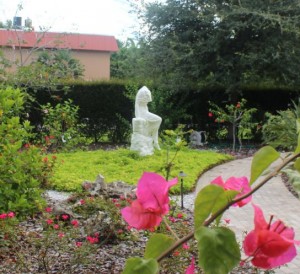 thoughtfully included $200 to have the statue moved from her home [at 410 First Street] to the library grounds.
thoughtfully included $200 to have the statue moved from her home [at 410 First Street] to the library grounds. - The account misspells the donor’s name (which is Rea), and the actual will makes no provision for a cash gift to cover moving expenses, although it is conceivable that the executrix of Ms. Rea’s estate may have paid the cost of moving the sculpture to the library grounds.
- The Southwest Florida Museum of History also
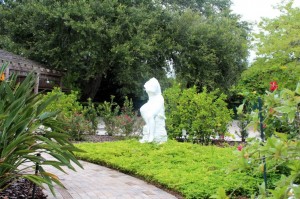 holds a record of a statement given by Lewis A. Pearl, who tended Ms. Rea’s garden. Pearl maintains that Ms. Rea wanted to give Lorelei to the Edison Estate, but the putative gift was refused by Robert Halgrim because it did not have a sufficient connection to the Edisons, who admired it on one or more occasions in Ms. Rea’s garden.
holds a record of a statement given by Lewis A. Pearl, who tended Ms. Rea’s garden. Pearl maintains that Ms. Rea wanted to give Lorelei to the Edison Estate, but the putative gift was refused by Robert Halgrim because it did not have a sufficient connection to the Edisons, who admired it on one or more occasions in Ms. Rea’s garden. 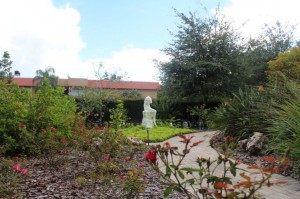 On February 5, 1985, Southwest Florida Museum of History Director Patty Bartlett interviewed Lewis’s son, Bob Pearl, who speculated that the sculpture may have gone from Rea’s garden to that of a Mrs. Chadwick before it went on to the library. However, there exists no evidence to substantiate this claim, and it would have been a breach of fiduciary
On February 5, 1985, Southwest Florida Museum of History Director Patty Bartlett interviewed Lewis’s son, Bob Pearl, who speculated that the sculpture may have gone from Rea’s garden to that of a Mrs. Chadwick before it went on to the library. However, there exists no evidence to substantiate this claim, and it would have been a breach of fiduciary 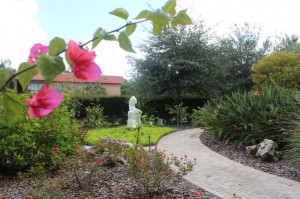 duty for the executrix to move the sculpture to someone else’s home prior to distributing the siren to the library in keeping with the devise mandated by the will.
duty for the executrix to move the sculpture to someone else’s home prior to distributing the siren to the library in keeping with the devise mandated by the will.- According to Director Sheldon Kaye, the Lee County Library System did not exist at either the time Ms. Rea made her will or it was admitted into probate in 1959. Thus, it is presumed that Lorelei’s ownership is vested in the City of Fort Myers rather than either the library or Lee County. Lee County agrees, as it omitted Lorelei from the inventory and appraisal it made of its public art holdings in 1999.
Updates and Recent Developments
One year after being relocated, Garden Council begins Lorele’s conservation (01-06-15)
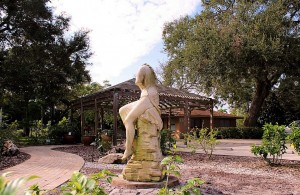 One year after providing her with a new home, the Fort Myers-Lee County Garden Council is following through on its promise to clean and polish Lorelei, the 134-year-old German siren that graced the front entry of the Fort Myers-Lee County Regional Library on Jackson Street from 1961 to January 6, 2014.
One year after providing her with a new home, the Fort Myers-Lee County Garden Council is following through on its promise to clean and polish Lorelei, the 134-year-old German siren that graced the front entry of the Fort Myers-Lee County Regional Library on Jackson Street from 1961 to January 6, 2014.
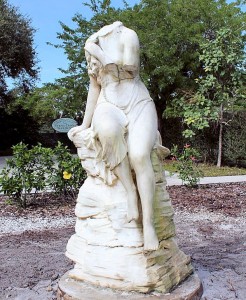 When the library moved two Septembers ago to its new 40,000-square-foot quarters at the corner of First and Royal Palm Boulevard, Lorelei was left behind. Not only did the classical sculpture not complement the modernist architectural style that the library adopted for their new location, the statue was in dire need of significant and costly repairs and maintenance. Lorelei’s head, left elbow and toes were lost when one or more vandals damaged the sculpture on the night of October 29, 1997 (the culprits were never caught and the missing pieces have never resurfaced), and the delicate Italian marble had been sullied, stained and covered
When the library moved two Septembers ago to its new 40,000-square-foot quarters at the corner of First and Royal Palm Boulevard, Lorelei was left behind. Not only did the classical sculpture not complement the modernist architectural style that the library adopted for their new location, the statue was in dire need of significant and costly repairs and maintenance. Lorelei’s head, left elbow and toes were lost when one or more vandals damaged the sculpture on the night of October 29, 1997 (the culprits were never caught and the missing pieces have never resurfaced), and the delicate Italian marble had been sullied, stained and covered 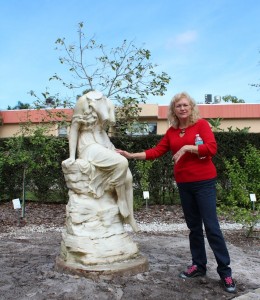 with mold and mildew from the plants that surrounded her and the sprinklers that irrigated them in the landscaping bed that were Lorelei’s home for some 53 years. To make matters worse, UV damage from direct sunlight and exposure to more than half a century of wind and rain had caused the marble to flake.
with mold and mildew from the plants that surrounded her and the sprinklers that irrigated them in the landscaping bed that were Lorelei’s home for some 53 years. To make matters worse, UV damage from direct sunlight and exposure to more than half a century of wind and rain had caused the marble to flake.
The City of Fort Myers Public Art Committee hired a conservator in March of 2014 to tell them what it would cost to clean and stabilize the marble and replace the missing head, left elbow and toes. While conservators Rosa Lowinger and Lauren Hall did not feel that the 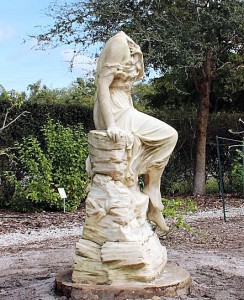 missing body parts should be replaced because the vandalism is now part of the sculpture’s history, they did estimate that it would cost more than $6,000 just to remove the mold and mildew and give Lorelei a good bath and injections to arrest the spalling. But the Public Art Committee did not have the money to relocate, never mind conserve the statue, and for a time it looked like the City might have to sell or de-accession the woeful siren from its public art collection.
missing body parts should be replaced because the vandalism is now part of the sculpture’s history, they did estimate that it would cost more than $6,000 just to remove the mold and mildew and give Lorelei a good bath and injections to arrest the spalling. But the Public Art Committee did not have the money to relocate, never mind conserve the statue, and for a time it looked like the City might have to sell or de-accession the woeful siren from its public art collection.
At the last minute, the Fort Myers – Lee County Garden Council came to Lorelei’s rescue. “When we read about Lorelei’s plight in the River Weekly, we knew we had to do 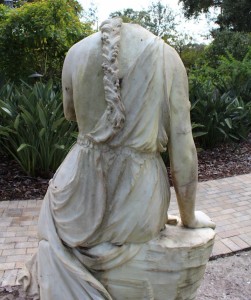 something,” said Kay Holloway last year as she and a group of other Garden Council members watched anxiously as a four-man crew from Flint & Doyle unloaded the heavy five-foot-tall sculpture from the flatbed truck they’d used to transport her from the old library adjacent to the Southwest Florida Museum of History on Jackson Street.
something,” said Kay Holloway last year as she and a group of other Garden Council members watched anxiously as a four-man crew from Flint & Doyle unloaded the heavy five-foot-tall sculpture from the flatbed truck they’d used to transport her from the old library adjacent to the Southwest Florida Museum of History on Jackson Street.
“We are over-the-top excited to bring her here,” added Second Vice-President Sandy Kavouras at the time. “It feels like she’s finally coming home.” Technically, Lorelei never actually spent time on the Garden Council grounds, but she did reside in the backyard of Evelyn D. Rea from 1930 until a 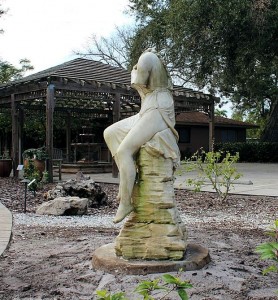 short time after Rea’s death in 1959. Rea was a member of the Periwinkle Garden Club and she maintained a well-tended garden at her residence on the Caloosahatchee River not far from the Garden Council grounds. The oldest garden club in Lee County, the Periwinkle was Mina Edison’s garden club, and she and husband Thomas were among the first guests to admire the sculpture after Ms. Rea installed Lorelei at her home following her return from Italy, where she found and purchased the sculpture that was created near Rome in 1880 by Boston-born artist Emma Elisabeth Phinney.
short time after Rea’s death in 1959. Rea was a member of the Periwinkle Garden Club and she maintained a well-tended garden at her residence on the Caloosahatchee River not far from the Garden Council grounds. The oldest garden club in Lee County, the Periwinkle was Mina Edison’s garden club, and she and husband Thomas were among the first guests to admire the sculpture after Ms. Rea installed Lorelei at her home following her return from Italy, where she found and purchased the sculpture that was created near Rome in 1880 by Boston-born artist Emma Elisabeth Phinney.
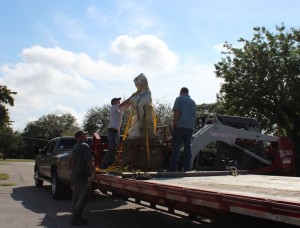 The Periwinkle was one of nine garden clubs who banded together in 1957 to form the Garden Council. Today, it is one of the Council’s twenty member garden clubs, eight plant societies and two affiliates which, together, boast more than 1,800 individual members throughout Southwest Florida. The Council moved to its current location on Virginia in 2007 compliments of a long-term lease from the City of Fort Myers.
The Periwinkle was one of nine garden clubs who banded together in 1957 to form the Garden Council. Today, it is one of the Council’s twenty member garden clubs, eight plant societies and two affiliates which, together, boast more than 1,800 individual members throughout Southwest Florida. The Council moved to its current location on Virginia in 2007 compliments of a long-term lease from the City of Fort Myers.
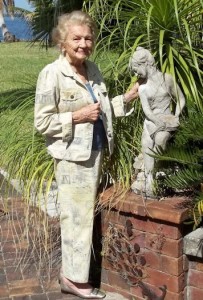 To be sure, the Garden Council does not have a surfeit of funds to underwrite Lorelei’s care, custody and conservation. But they did manage to induce Flint & Doyle to move the sculpture gratis to her home in the Berne Davis Garden at the Garden Council. And the Garden Council got the money to clean and conserve the sculpture from a fund that the 100-year-old philanthropist established at the Southwest Community Fund for special projects.
To be sure, the Garden Council does not have a surfeit of funds to underwrite Lorelei’s care, custody and conservation. But they did manage to induce Flint & Doyle to move the sculpture gratis to her home in the Berne Davis Garden at the Garden Council. And the Garden Council got the money to clean and conserve the sculpture from a fund that the 100-year-old philanthropist established at the Southwest Community Fund for special projects.
“We couldn’t be more grateful,” Holloway said in a telephone interview earlier today. “The Foundation even provided us with enough money for some re-landscaping and proper signage.”
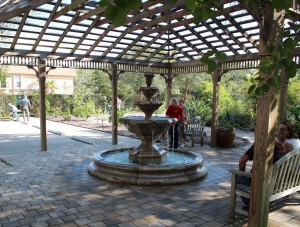 Of course, the conservation work being performed today and tomorrow by Miami-based Rosa Lowinger and Associates is not a permanent fix. “Any outdoor artwork will require regular maintenance,” notes Kelly Ciociola, Associate Conservator at Lowinger and Associates. And the UV damage from the Southwest Florida sun remains a problem. “But she’s in a much better place now than a year ago. There are no plants abutting her and there are no sprinklers dousing her. Of course, indoors is the most climate controlled.”
Of course, the conservation work being performed today and tomorrow by Miami-based Rosa Lowinger and Associates is not a permanent fix. “Any outdoor artwork will require regular maintenance,” notes Kelly Ciociola, Associate Conservator at Lowinger and Associates. And the UV damage from the Southwest Florida sun remains a problem. “But she’s in a much better place now than a year ago. There are no plants abutting her and there are no sprinklers dousing her. Of course, indoors is the most climate controlled.”
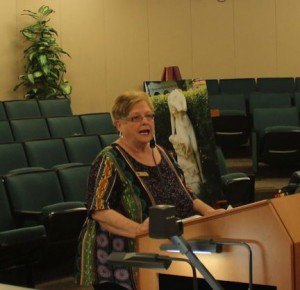 But Lorelei has lived all her life outdoors and her namesake in the Rhine Valley would never tolerate being sequestered inside. But that’s okay. Going forward, Holloway and the Garden Council are committed to provide Lorelei what she needs so that she can be enjoyed for generations to come at her new home on Virginia in the Berne Davis Gardens. The Fort Myers-Lee County Garden Council is open to the public from 10:00 a.m. to 1:oo p.m. on Tuesdays. The gardens are located at 2166 Virginia Avenue (off McGregor Blvd), Fort Myers, Florida 33901. For more information, please telephone 239-332-4942 or visit www.fmlcgardencouncil.com
But Lorelei has lived all her life outdoors and her namesake in the Rhine Valley would never tolerate being sequestered inside. But that’s okay. Going forward, Holloway and the Garden Council are committed to provide Lorelei what she needs so that she can be enjoyed for generations to come at her new home on Virginia in the Berne Davis Gardens. The Fort Myers-Lee County Garden Council is open to the public from 10:00 a.m. to 1:oo p.m. on Tuesdays. The gardens are located at 2166 Virginia Avenue (off McGregor Blvd), Fort Myers, Florida 33901. For more information, please telephone 239-332-4942 or visit www.fmlcgardencouncil.com
Related Articles and Links.
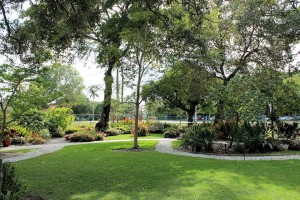 Field Notes: Historic Lorelei statue beheaded but bewitching (03-02-14)
Field Notes: Historic Lorelei statue beheaded but bewitching (03-02-14)- Lorelei finds new home at Fort Myers-Lee County Garden Council (01-06-14)
- Headless sculpture Lorelei could be sold or moved when library moves (06-10-13)
- Deciding whether Lorelei should be restored to her former glory – 3 (02-13-13)
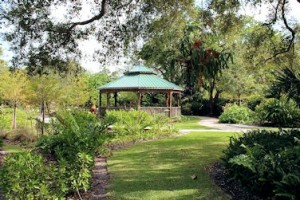 Deciding whether Lorelei should be restored to her former glory – 2 (02-11-13)
Deciding whether Lorelei should be restored to her former glory – 2 (02-11-13)- Deciding whether Lorelei should be restored to her former glory – 1 (02-09-13)
- Library’s Lorelei can’t sing without her missing head (07-11-12)
- The legend of Lorelei, the siren who inspired Fort Myers’ headless statue (07-11-12)














 Tom Hall is both an amateur artist and aspiring novelist who writes art quest thrillers. He is in the final stages of completing his debut novel titled "Art Detective," a story that fictionalizes the discovery of the fabled billion-dollar Impressionist collection of Parisian art dealer Josse Bernheim-Jeune, thought by many to have perished during World War II when the collection's hiding place, Castle de Rastignac in southern France, was destroyed by the Wehrmacht in reprisal for attacks made by members of the Resistance operating in the area. A former tax attorney, Tom holds a bachelor's degree as well as both a juris doctorate and masters of laws in taxation from the University of Florida. Tom lives in Estero, Florida with his fiancee, Connie, and their four cats.
Tom Hall is both an amateur artist and aspiring novelist who writes art quest thrillers. He is in the final stages of completing his debut novel titled "Art Detective," a story that fictionalizes the discovery of the fabled billion-dollar Impressionist collection of Parisian art dealer Josse Bernheim-Jeune, thought by many to have perished during World War II when the collection's hiding place, Castle de Rastignac in southern France, was destroyed by the Wehrmacht in reprisal for attacks made by members of the Resistance operating in the area. A former tax attorney, Tom holds a bachelor's degree as well as both a juris doctorate and masters of laws in taxation from the University of Florida. Tom lives in Estero, Florida with his fiancee, Connie, and their four cats.
Excellent work! We are indebted to you for your excellent research and writing on this subject. Thank you.
When you have finished your book, please let us know where we can find it. Your writing is too good to overlook.